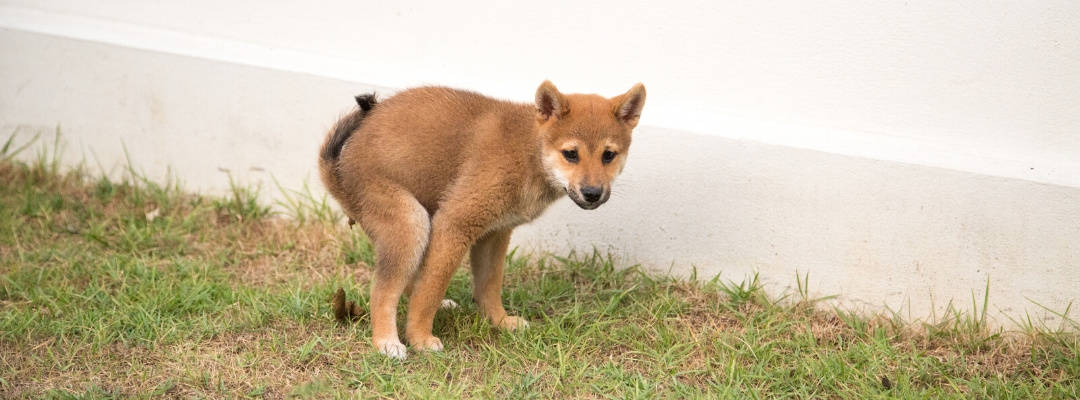Trying to enjoy the yard that you’ve taken meticulous care of is next to impossible when the local dogs decide your lawn is best suited for other purposes. Most of us know exactly what it feels like to step in a fresh pile of dog poop, and it is far from a pleasant feeling, particularly if you happen to be wearing sandals, or worse, are barefoot.
So, what can be done to stop a dog from turning your yard into his own personal bathroom?
How can you keep dogs from pooping in your yard?
Well, we’ve got some tried and true suggestions for you to experiment with to put an end to this impolite behavior.
Feel free to try any of the following tips, or combine a couple of them to find a perfect dynamic duo that works for you, but, for the sake of good neighborly relations and common courtesy, we recommend starting with the first tip to see if you can avoid proceeding with more drastic measures.
Have a Heart-to-Heart Chat With the Perpetrator’s Owner
A meaningful conversation backed with good intentions may very well be enough to stop the issue of unwanted “gifts” appearing in your yard and negate the need for any further action on your part. It’s definitely worth a try.
Before Your Chat
Before you head over to the owner’s house, be sure that you are approaching the right person. You don’t want to make a scene with someone who is not at fault. Also, keep in mind that the owner may be unaware that his dog has been visiting your yard to make his daily deposits.
If possible, try to snap a picture of the dog in action before you talk with the owner. That way you will have evidence in your hand that the crime actually occurred and of who the guilty party is.
Wait until you are calm and collected. Words spoken in anger rarely produce desired results. The old proverb, “You can catch more flies with honey than with vinegar,” usually holds true.
If you’re feeling especially benevolent, prepare a plate of homemade goodies to bring along to help set the right mood for your conversation.
Ready, Set, Go
- Armed with a pleasant attitude, an incriminating picture in your pocket, and perhaps a few sweets, head on over to the owner’s house.
- If necessary, politely introduce yourself first as you hand over the plate of treats. Calmly explain the situation that you’ve been dealing with and why exactly it’s a problem.
- If the owner denies that his dog is guilty, produce your evidence, but be nice about it.
- Say something like, “I really like dogs and understand that dogs will be dogs. The thing is, I’ve worked hard to keep my yard in pristine condition. Is there any way you could walk your dog on the other side of the street or keep him in your yard?”
- Hopefully, the owner will agree to and honor your request. Problem solved.
- If the conversation heads south rapidly, mention that you really hoped that the issue could be resolved in a friendly manner but are prepared to take more drastic action.
- Then walk away. Don’t stick around long enough for an argument or fight to break out. Your implied threat may be sufficient to make him think twice about allowing his dog to venture onto your property.
If the problem persists after you’ve confronted the person responsible, give being nice one last shot. Buy some pet waste bags or maybe even a tie-out system for his dog. Both of these gifts are rather inexpensive, and your thoughtfulness and generosity might just do the trick to change the owner’s careless ways.
Pros:
- May resolve the problem once and for all.
- Maintains a good relationship if handled well.
- Conversation is free.
- No physical labor or landscape changes are involved.
Cons:
- Not effective if you are dealing with a stray dog.
- Not everyone will respond as you hope – some people can be downright nasty.
Install a Motion-Activated Device
Strategically placing a motion-activated gadget or two to target areas that are most often visited by dogs in need of a bathroom break is a simple, effective method of keeping unwanted visitors off of your lawn.
Ultrasonic and Flashing Light Devices
Most dogs don’t take too kindly to being startled with a sudden burst of annoying noise and a bright, flashing strobe light. Installing a motion-activated ultrasonic pet repeller to cover areas frequented by neighborhood dogs only takes a moment as you push the device’s stake into the ground.
These units are only activated when a dog (or other creatures including a person) steps into the zone covered by the infrared sensor. Most of these devices can pick up on animal movement up to 30 feet away, cover a 110-degree area, are weather-proof, and are powered by a solar panel on top so you won’t have to deal with cords snaking through your yard.
Additionally, most motion-activated repellers are completely adjustable. You can set the sensitivity and frequency to fit your situation and repel target animals.
Sprinklers
Motion-activated sprinklers work in a similar way as the ultrasonic devices as far as motion detection is concerned. However, instead of flashing lights and ultrasonic sounds, trespassing dogs will receive a short, powerful blast of water.
These startling sprinklers are a much better option than hiding in the bushes with your hose (yes, some frustrated homeowners have resorted to this) or leaving your regular sprinkler running for hours on end to deter uninvited dogs.
Pros:
- Effective on cats and other animals as well.
- Won’t harm dogs.
- Very effective when properly set up.
- Once installed, they do the work for you.
Cons:
- Motion-activated devices don’t discriminate – children who accidentally enter the target zone will receive an unpleasant surprise.
- Sprinklers are ineffective when temperatures plunge below freezing.
- You must remember to turn off the devices before taking your dog out or working in the area.
Create a Barrier
This method will involve some physical labor or make you dig a little deeper into your wallet, but erecting a physical barrier around your property will keep dogs away.
Fences
While you certainly can install a permanent surrounding fence with each post set in concrete to block entrance to your property, there are other, less labor-intensive options available.
Depending on the size of your yard, a free-standing fence may be ideal. To use, simply set up the panels where you like and walk away. This portable fence will only be a psychological deterrent and should not be trusted to keep your own pets safely confined to your yard.
Decorative garden fencing can also be used to cordon off your yard in style. These panels are typically stronger and more secure than fencing that stands alone as they have stakes that must be driven into the ground. There are even sturdy fencing panels that have the option of mounting the posts onto pre-existing concrete or directly into soil.
One creative and budget-friendly idea is to use an Evenflow Play Space designed to safely contain small children when playing outside. Instead of forming a circle with the panels, simply stretch them out into a straight line to block access to your yard. Stakes to secure the pieces are included.
Living Barriers
Planting a thorny, living barrier across the front of your yard (or wherever the dogs are entering) can greatly help to deter four-legged intruders and add beauty to your landscape at the same time.
Rose bushes, trifoliate orange shrub, or Japanese barberry can all be grown to form a dense, protective barrier. Raspberry or gooseberry plants not only have dog-deterring thorns but will also reward you with delicious fruit once a year.
Ground Cover Border
As difficult as it may be, removing some of your lawn to create a grassless perimeter may be worth doing. Once a wide, bare border has been created, fill in the blank space with something that dogs find unpleasant to walk on.
Sharp lava rocks or pine cones will be quite uncomfortable for a dog to maneuver across. If you have access to an abundance of crushed or broken seashells or even crushed pecan shells, either of those options would make an effective deterrent. Just be sure that the border is wide enough that a dog can not simply hop over it.
Pros:
- Effective.
Cons:
- Can be costly and labor-intensive.
- Neighbors may not appreciate your new installment.
Apply Repellents
A dog’s sense of smell is much more finely tuned than ours is and for most dogs, strong smells are a big turn-off. Use this to your advantage when choosing an outdoor repellent.
Commercial Dog Repellent Products
Dog repellents are available in liquid form, such as Jim’s All-Natural Animal Repellent, or granular form, like Scram For Dogs. These repellents work well with some dogs while other dogs don’t seem bothered by them at all. Still, they might be worth a try if you are wary of seeing piles of poop in your yard.
Homemade Repellent
Whipping up a batch of homemade repellent is quick and easy to do. Fresh hot peppers or citrus essential oils can be turned into a powerful repellent. For a more complete guide on homemade deterrents, head on over to our article on preventing dogs from peeing on plants.
Pros:
- Simple to apply.
- No need to apply to your entire yard, just the perimeter.
Cons:
- May not work with all dogs.
- Must be reapplied every few weeks or after heavy rain.
Tip: Be sure to remove all traces of pet waste from your yard before applying repellents. Spraying areas that have been soiled with an outdoor odor eliminating spray will stop dogs from being attracted to previously used potty spots.
Bottles of Water
This solution may sound too simple to be true, but many people swear it works. Here’s what to do. Fill a few empty soda bottles with water and place them in the sunlight around the edge of your yard. Shallow containers filled with water will also do the trick.
You’re probably wondering why water would repel dogs. Well, the truth is, no one is quite sure. Some people think that dogs don’t care for the way the sunlight is reflected off the water. Others believe it works because dogs naturally avoid doing their business close to food or water sources.
Pros:
- Free to try if you have a couple of empty bottles on hand.
- Not very noticeable if well placed or partially buried.
Cons:
- Those under the rule of homeowners’ associations may not be permitted to leave bottles of water in plain sight.
Put Up a Sign
We’ve all seen the standard No Dogs Allowed signs posted on storefronts and playgrounds, but did you know that you can place one in your own yard? Some, like our favorite, are a tad humorous and depict a dog hunched over producing a fresh pile with the words, “Please be respectful,” encircling the image.
Pros:
- May make inconsiderate dog walkers avoid the sidewalk in front of your house.
- Affordable and easy to stick in the ground.
Cons:
- Your neighbors may not feel that an image of a dog pooping is appropriate outdoor décor.
- Dogs off-leash will not be deterred by your subtle message.
Contact Animal Control
If all else has failed, contacting your local animal control officer may be done as a last resort. Officers may attempt to round up stray dogs or fine dog owners who allow their dogs to run loose or fail to clean up behind them on walks.
Know that dogs picked up by animal control or confiscated from owners will wind up at the local shelter where they may only be given a few weeks at a chance for adoption before being euthanized. Be certain that there are no other options before resorting to this measure.
Pros:
- The situation will most likely be resolved.
Cons:
- This is a sure-fire way to make enemies of your neighbors.
- You may be sentencing a dog to an untimely end.





